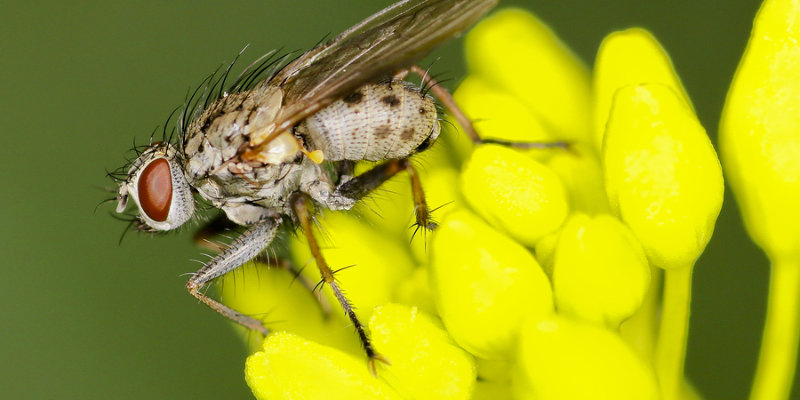Adult tachinid flies can superficially resemble houseflies, but vary by species in size, coloration and shape. Many are gray or black or have bodies marked with stripes. Many have distinct long bristles on the ends of their abdomens. However, some species are brightly colored (e.g., with a red abdomen and smoky black wings), and they may have prominent fringes of hairs along their hind legs. Larval (maggot) stages are rarely seen, but they may be observed when they emerge from host insects to pupate.

- Some species of flesh flies (Diptera: Sarcophagidae) are also parasitic on some species of bees (Hymenoptera), beetles (Coleoptera) and caterpillars (Lepidoptera). Some species of humpbacked flies (Diptera: Phoridae) parasitize species of ants and bees (Hymenoptera), beetles (Coleoptera) and scale insects (Homoptera). Some smaller groups of flies (Sciomyzidae, Pipunculidae, Pyrgotidae, Anthomyiidae) also contain parasitic species.
- Life cycles vary by species. Eggs are sometimes laid on leaves and ingested by a host caterpillar during feeding. Female flies of other species may glue their eggs to the hosts’ body after which the hatching larva tunnels inside. In other species, eggs are inserted directly into the hosts’ body by the female. Once inside the body of the host, one or more larvae can develop through several stages (instars) for 4 to 14 days. They emerge from the host to pupate inside their last larval skin (puparium). Adults emerge 1 to 2 weeks later. Depending on species one or more generations occur per year.
- Larvae (maggots) with hook-like mouthparts that tease apart tissues of their hosts. Adults have lapping mouthparts similar to those of houseflies. Individual species are generally host-specific. As a group, most species parasitize caterpillars (Lepidoptera) or beetles (Coleoptera). However, some species develop in sawflies (Hymenoptera), true bugs (Hemiptera), grasshoppers (Orthoptera) or other insects. Adult flies can be found while they visit flowers. Immature stages are only found in parasitized host insects. Stink bugs (Hemiptera) that are easily collected in rice or soybean fields or various caterpillars can be a good source for some tachinid fly parasites.
- Larval stages develop inside developmental stages of other insects; beneficial insects; medically harmless.
At Longhorn Termite & Pest Control, we offer flesh fly control services for customers in Azle, Weatherford, Benbrook, and Graham, Texas.
